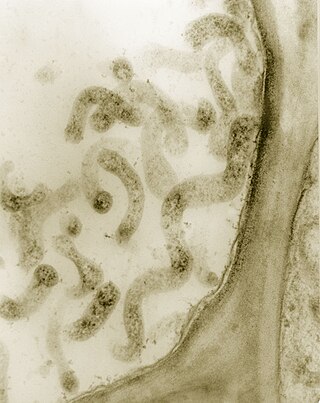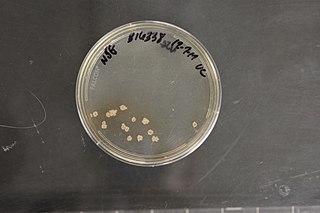The Syntrophobacterales are an order of Thermodesulfobacteriota. All genera are strictly anaerobic. Many of the family Syntrophobacteraceae are sulfate-reducing. Some species are motile by using one polar flagellum.

Treponema is a genus of spiral-shaped bacteria. The major treponeme species of human pathogens is Treponema pallidum, whose subspecies are responsible for diseases such as syphilis, bejel, and yaws. Treponema carateum is the cause of pinta. Treponema paraluiscuniculi is associated with syphilis in rabbits. Treponema succinifaciens has been found in the gut microbiome of traditional rural human populations.

The Spirochaetales are an order of spirochete bacteria. Some species within this order are known to causes syphilis, Lyme disease, relapsing fever, and other illnesses.

Entomoplasmatales is a small order of mollicute bacteria.

The Actinomycetia are a class of bacteria.

The Acidimicrobiaceae are a family of Actinomycetota.
The Coriobacteriaceae is a family of Actinomycetota. The family Coriobacteriaceae has been shown to increase significantly in the ceca of mice in response to stress.
Rubrobacter is a genus of Actinomycetota. It is radiotolerant and may rival Deinococcus radiodurans in this regard.

The Paenibacillaceae are a family of Gram-positive bacteria.
The Halanaerobiales are an order of bacteria placed within the class Clostridia, and encompassing two families, the Halanaerobiaceae and the Halobacteroidaceae. Originally placed within the highly polyphyletic class Clostridia, according to the NCBI and LPSN, it is now thought to lie outside the Bacillota. Halanaerobiales are halophilic obligate anaerobes with a fermentative or homoacetogenic metabolism.
The Eubacteriaceae are a family of Gram-positive bacteria in the order Clostridiales.
Megasphaera is a genus of Bacillota bacteria classified within the class Negativicutes.

The Glycomycetaceae are a family of bacteria.
The Selenomonadales are an order of bacteria within the class Negativicutes; unlike most other members of Bacillota, they are Gram-negative. The phylogeny of this order was initially determined by 16S rRNA comparisons. More recently, molecular markers in the form of conserved signature indels (CSIs) have been found specific for all Selenomonadales species. On the basis of these markers, the Selenomonadales are inclusive of two distinct families, and are no longer the sole order within the Negativicutes. Several CSIs have also been found specific for both families, Sporomusaceae and Selenomonadceae. Samples of bacterial strains within this order have been isolated from the root canals of healthy human teeth.

The Acidimicrobiia are a class of Actinomycetota, in which three families, eight genera, and nine species have been described, Acidimicrobium ferrooxidans is the type species of the order.

The Micrococcales are an order of bacteria in the phylum Actinomycetota.
The Nocardiopsaceae are a family of bacteria.
Euzebya is a genus of Gram-positive bacteria.

The Treponemataceae are a family of spirochete bacteria. The clade includes a number of significant pathogens, such as Treponemapallidum, the cause of human syphilis.
Thermosipho is a genus of Gram-negative staining, anaerobic, and mostly thermophilic and hyperthermophilic bacteria in the family Thermotogaceae.







